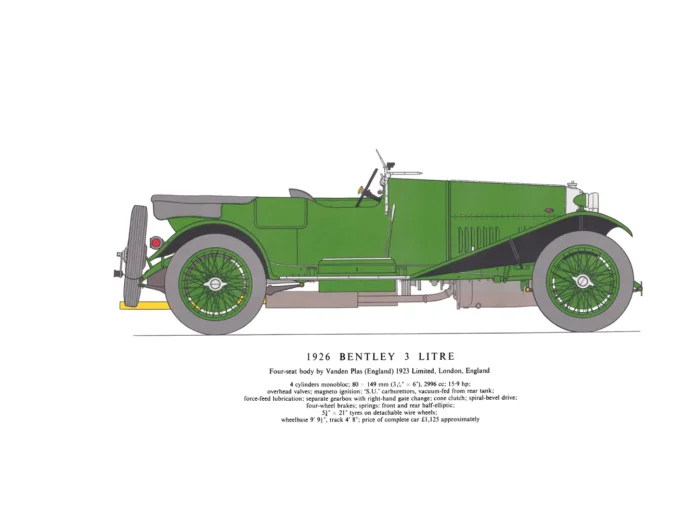1926 Bentley 3 Litre
Price range: £12.00 through £15.00
1926 Bentley 3 Litre (scroll down for a more detailed Description)
Published 1961 by © Hugh Evelyn Limited; drawn by George A. Oliver (1920-1990)
THIS PRINT IS AVAILABLE IN 2 SIZES
LARGE: Size: c. 47.5 x 34.5 cm [18 ½″ x 13 ½″]
STANDARD: Size: c. 33 x 24 cm [13″ x 9½″]
Both printed on medium white cardstock weighing c. 136 g/sm2
Shipping is the same for 1 to 10 prints (based on largest print size in your order – see Shipping & Returns.
Description
W.O. Bentley (‘W.O.’) was an engineer. He apprenticed with the Great Northern Railway. In the Great War, he pioneered the use of aluminium pistons in aero engines. With his brother, he began development of the Bentley 3 Litre at Cricklewood in 1919. These ‘running’ chassis were made available to coach builders from 1921 to 1929. Vanden Plas, in nearby Hendon, built more than 700 Bentley bodies. The 2,996 cc straight-4 engine was designed by ex-Royal Flying Corps engineer Clive Gallop. It was technically very advanced for its time – one of the first production engines with 4 valves per cylinder, dry-sump lubrication and an overhead camshaft. [In 1915 W.O. had suggested confiscating a Mercedes GP racer marooned in their London showroom at the outbreak of war. Appropriated by the army it was dismantled by Rolls-Royce.] The Bentley 4-valve SOHC Hemi design, with a bevel-geared camshaft drive, was based on that Mercedes engine. The chassis was designed by Humber’s Frederick Tasker Burgess, a colleague of W.O. in the War. After the war 1368 cc Bugattis dominated racing; but double the engine size and the sheer strength of the Bentley compensated for the extra weight. The 1800 kg car won Le Mans in 1924 and 1927 prompting Ettore Bugatti to call it “the fastest lorry in the world.”
Additional information
| Weight | 0.0227 kg |
|---|---|
| Dimensions | 48 × 35 cm |





